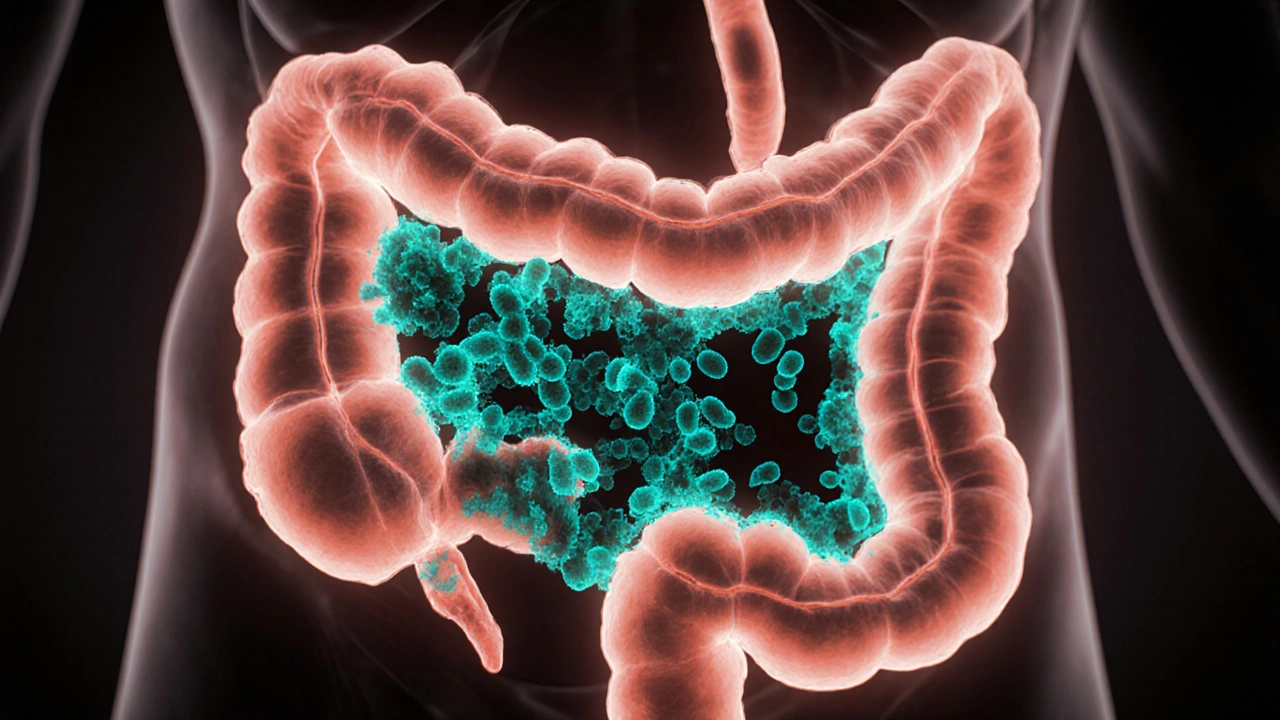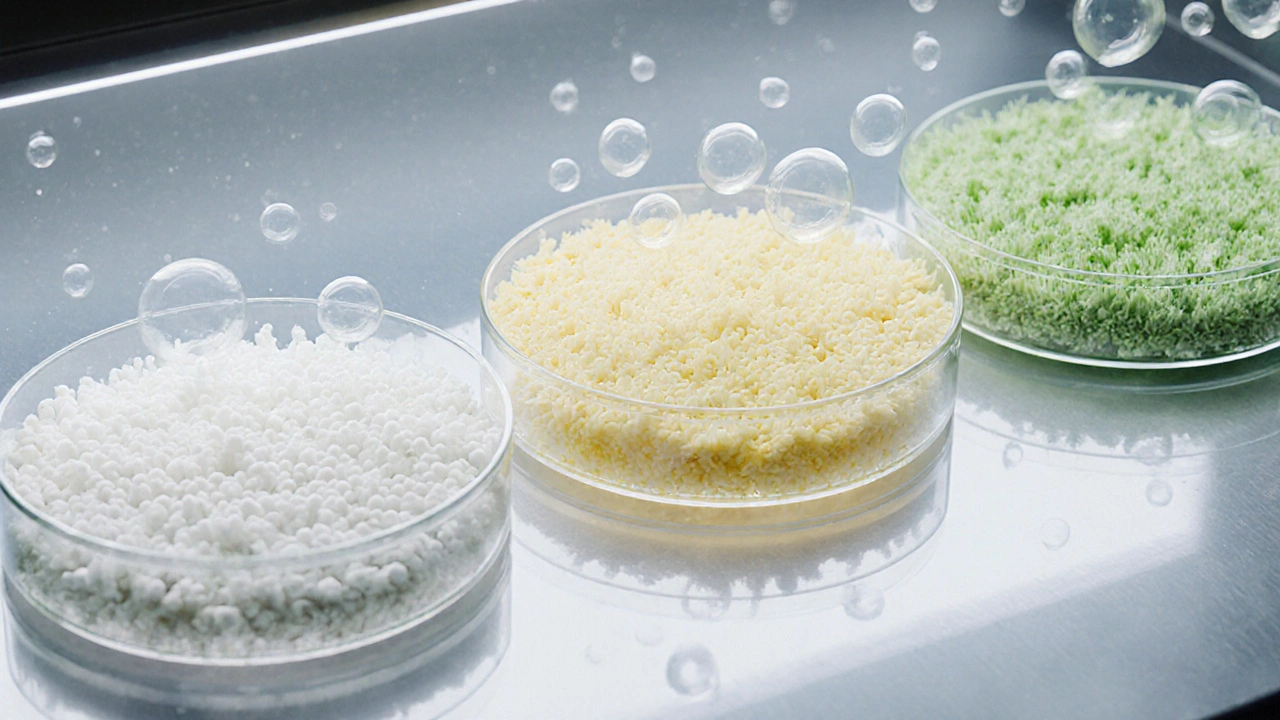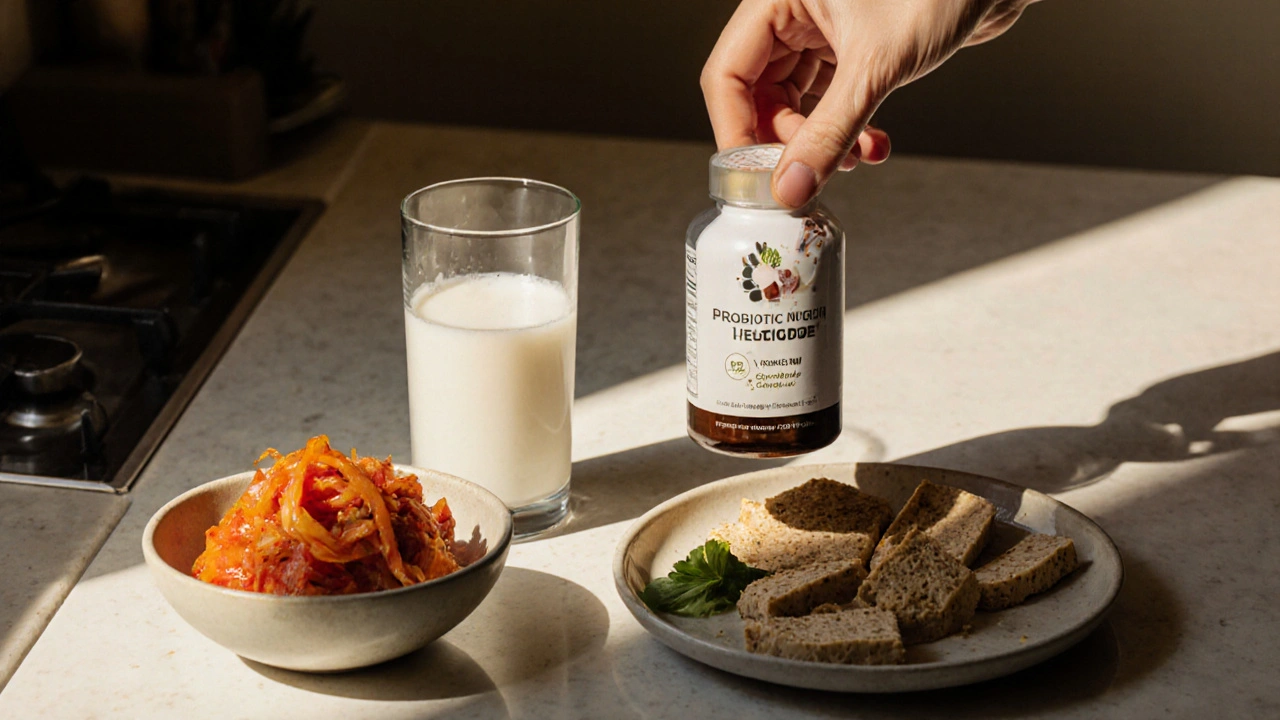
Probiotic Gas Reduction Calculator
How It Works
This calculator helps you determine the right probiotic dosage based on the strains shown in our article. Enter your target CFU (Colony Forming Units) and select your preferred strain to see how to achieve it through foods or supplements.
Your Recommended Daily Intake
Strain
Target CFU
Optimal Timing
Sources to Achieve This Dose
Quick Takeaways
- Probiotics balance the gut microbiome, which can cut down on excess gas.
- Specific strains-like Lactobacillus and Bifidobacterium-are most effective against flatulence.
- Eating fermented foods or taking a quality supplement delivers the right microbes.
- Pair probiotics with prebiotic fibers for best results.
- If gas persists despite a probiotic plan, consult a healthcare professional to rule out underlying issues.
What Probiotics are
When you hear the word probiotics, think of live microorganisms that, when consumed in adequate amounts, give a health boost. They’re not a drug; they’re friendly bacteria (or yeasts) that settle in your intestines and help keep the ecosystem balanced.
The gut microbiome is the collective community of trillions of microbes living in the digestive tract. A healthy microbiome digests food, creates vitamins, and keeps harmful pathogens in check. When this balance tips-often because of antibiotics, poor diet, or stress-you may notice bloating, irregular bowels, or loud, persistent gas.
Probiotics act like a repair crew, repopulating the gut with good microbes, nudging the ecosystem back toward equilibrium, and in the process, they can calm the fermentation processes that produce excess flatulence.

Why Flatulence Happens and How Probiotics Interfere
Flatulence is mostly nitrogen, hydrogen, carbon dioxide, methane, and a smidge of sulfur compounds. It’s generated when the gut bacteria break down undigested carbs through fermentation. If the bacterial mix over‑produces hydrogen or methane, you’ll feel more pressure and hear more noise.
Here’s where probiotics help:
- Competition: Good bacteria out‑compete gas‑producing species for nutrients, reducing the substrate available for fermentative gas production.
- Enzyme Support: Some strains produce enzymes that finish carbohydrate breakdown, leaving less to ferment.
- pH Regulation: By producing short‑chain fatty acids, probiotics lower colonic pH, creating an environment less friendly to gas‑heavy microbes.
Studies from 2022‑2024 show that participants who took specific probiotic blends reported a 30‑40% drop in daily gas episodes compared with placebo.
Top Probiotic Strains for Tackling Gas
Not all microbes are created equal. Research points to a handful of strains that consistently show benefits for bloating and flatulence.
| Strain | Primary Gas‑Reducing Action | Typical Daily Dose (CFU) | Common Food Sources / Supplements |
|---|---|---|---|
| Lactobacillus plantarum | Breaks down oligosaccharides that usually ferment into gas | 5‑10×10⁹ | Fermented veggies, kefir, targeted capsules |
| Bifidobacterium infantis | Reduces hydrogen production; supports short‑chain fatty acid formation | 3‑8×10⁹ | Yogurt, fortified drinks, probiotic powders |
| Saccharomyces boulardii | Yeast probiotic that limits pathogenic bacterial overgrowth | 1‑5×10⁹ | Capsules, some probiotic blends |
| Lactobacillus reuteri | \nProduces reuterin, a compound that suppresses gas‑producing microbes | 2‑10×10⁹ | Fermented dairy, chewable tablets |
When selecting a supplement, look for products that list the exact strain name (e.g., Lactobacillus plantarumLP299v) and guarantee the stated colony forming units (CFU) through the expiration date.
How to Choose & Use Probiotics Effectively
- Identify the problem: If you mainly experience gas after high‑fiber meals, prioritize strains that break down fermentable carbs (like Lactobacillus plantarum).
- Check the label: Ensure the product specifies strain, CFU count, and storage conditions. Refrigerated strains stay potent longer.
- Start low, go slow: Begin with half the recommended dose for a week to see how your gut reacts, then increase to full dose.
- Time it right: Take probiotics 30minutes before a meal or right after-this buffers the microbes from stomach acid.
- Pair with prebiotics: Foods rich in inulin, chicory root, or banana provide fuel for the good bacteria, amplifying their effect.
- Stay consistent: Benefits appear after 1‑3weeks of daily use. Skipping days can reset progress.

Probiotic‑Rich Foods & Lifestyle Tips
Supplements are convenient, but whole foods deliver a cocktail of microbes and nutrients. Incorporate these into daily meals:
- Kefir: A fermented milk drink containing multiple lactobacilli and yeasts.
- Sauerkraut & kimchi: Fermented cabbage supplies Lactobacillus strains.
- Tempeh: Fermented soy bean cake, rich in Bifidobacterium.
- Yogurt with live cultures: Look for “contains live and active cultures” on the label.
Beyond food, keep these habits:
- Stay hydrated-water helps microbes travel through the gut.
- Chew food thoroughly to reduce the workload on gut bacteria.
- Avoid excessive artificial sweeteners; they can feed gas‑producing microbes.
- Manage stress with mindfulness or light exercise; stress hormones disrupt microbial balance.
Potential Pitfalls & When to Seek Medical Advice
Probiotics are safe for most adults, but watch out for:
- Immune compromise: People with weakened immune systems may develop infections from certain strains, especially Saccharomyces boulardii.
- Over‑use: Taking very high CFU counts for months can lead to small‑intestinal bacterial overgrowth (SIBO) in susceptible individuals.
- Allergic reactions: Rare, but some may react to dairy‑based probiotic products.
If you notice persistent bloating, abdominal pain, diarrhea, or weight loss despite probiotic use, see a doctor. Tests for SIBO, lactose intolerance, or IBS may be needed.
Frequently Asked Questions
Can probiotics eliminate all flatulence?
No. Probiotics can cut down excessive gas by balancing gut microbes, but normal digestion still produces some gas. Expect a noticeable reduction, not a total stop.
How long does it take to feel the effects?
Most people notice less bloating within 7‑10days. Full benefits, especially for chronic gas, can take 3‑4weeks of consistent use.
Do I need a supplement if I eat fermented foods?
Fermented foods provide a solid foundation, but supplements let you hit a precise CFU target and ensure you get the most studied strains for gas reduction.
Are there any side effects?
Mild gas or bloating can appear when you first start, usually settling after a few days. Serious side effects are rare and mostly limited to immune‑compromised individuals.
What’s the difference between probiotics and prebiotics?
Probiotics are live microbes you ingest; prebiotics are nondigestible fibers that feed those microbes. Using both together gives a synergistic boost.
By understanding the science, picking the right strains, and pairing them with a gut‑friendly diet, you can turn those noisy, uncomfortable moments into a calmer, healthier digestive experience.
Comments (15)
-
Avinash Sinha October 13, 2025
Wow, reading this felt like a roller‑coaster through my gut! The breakdown of each probiotic strain was as vivid as a fireworks display in a night sky, and I could practically smell the kefir. I love how you paired the dosage calculator with real‑world food sources – that’s the kind of practical magic we need. Your tip about pairing prebiotics like bananas is pure gold, because who doesn’t want a banana‑powered gut? Keep the drama alive, because gut health is the new theatre of the body.
-
ADAMA ZAMPOU October 13, 2025
Having perused the exposition with meticulous scrutiny, I find the articulation of probiotic mechanisms both comprehensive and perspicuous. The author delineates the biochemical interplay with an admirable degree of precision, particularly in the context of short‑chain fatty acid production. One might, however, contemplate the longitudinal implications of sustained high‑CFU intake, an aspect perhaps meriting further elucidation. Nevertheless, the discourse stands as a commendable synthesis of contemporary gastro‑microbiological insights.
-
Liam McDonald October 14, 2025
I totally get how uncomfortable gas can be and this article really helps. The explanations about competition between good and bad microbes made sense and gave me hope. Starting with half the dose sounds wise especially if your gut is sensitive. Also, the timing tips – before meals – are something I’ll try tomorrow morning. Good luck to everyone on the journey to calmer bellies.
-
Adam Khan October 14, 2025
Your probiotic dosage calculator is a nifty tool.
-
rishabh ostwal October 14, 2025
While the hype around probiotics is intoxicating, let’s not pretend the science is settled. Many strains are touted without rigorous, double‑blind trials, and regulatory oversight remains lax. Consumers deserve transparent data, not just cherry‑picked studies that fit a marketing narrative. So, before you gorge on supplements, remember that a balanced diet still reigns supreme.
-
Kristen Woods October 14, 2025
i think the adivce is good but the grammer in the article is a littel off
-
Carlos A Colón October 14, 2025
Oh great, another miracle pill for gas, because we all love having a personal brass section in our intestines.
-
Rex Peterson October 14, 2025
From a philosophical standpoint, the pursuit of a less gassy existence mirrors humanity’s quest for inner tranquility. By modulating the microbial symphony within, we engage in a form of self‑directed alchemy, turning chaotic fermentation into harmonious equilibrium. Such an endeavor reflects the age‑old dialectic between chaos and order, now played out at a microscopic scale.
-
Candace Jones October 14, 2025
Great info! Remember to stay consistent for a few weeks and pair with fiber – you’ll notice a difference.
-
Scott Shubitz October 14, 2025
Listen, if you’re still getting winded after following these tips, you’re just being lazy about diet and lifestyle – no probiotic is going to fix that.
-
Soumen Bhowmic October 15, 2025
Let us embark on an exhaustive exploration of the nuanced roles that probiotic strains play in attenuating intestinal gas, for it is a subject that warrants more than a cursory glance.
First, one must appreciate the intricate ecological competition that unfolds within the colon, where beneficial microbes vie with gas‑producing bacteria for the same substrates.
Second, the enzymatic arsenal deployed by Lactobacillus plantarum, for instance, includes raffinose‑degrading enzymes that pre‑empt the formation of fermentable sugars.
Third, Bifidobacterium infantis exerts a modulatory effect on hydrogen production by steering carbohydrate metabolism toward short‑chain fatty acids.
Fourth, Saccharomyces boulardii, though a yeast, contributes by outcompeting pathogenic strains, thereby indirectly reducing gas‑forming pathways.
Fifth, Lactobacillus reuteri generates reuterin, a potent antimicrobial compound that suppresses methanogenic archaea.
Sixth, the timing of ingestion-whether before meals or with food-affects survivability through gastric acidity and thus colon colonization efficiency.
Seventh, the synergy between prebiotic fibers such as inulin and these probiotic strains cannot be overstated; the fibers act as a substrate that fuels the beneficial colonies.
Eighth, dosage matters: sub‑therapeutic CFU levels may be insufficient to shift the microbial balance, while excessive dosages risk small‑intestinal bacterial overgrowth.
Ninth, individual variability in baseline microbiota composition dictates responsiveness, so a one‑size‑fits‑all approach is naïve.
Tenth, the stability of the formulation-whether lyophilized, refrigerated, or encapsulated-determines the viability of the organisms upon consumption.
Eleventh, continual adherence over a period of three to four weeks is typically required before measurable reductions in flatulence manifest.
Twelfth, monitoring symptoms and adjusting strain selection based on personal response can fine‑tune outcomes.
Thirteenth, clinical studies from 2022‑2024 consistently report a 30‑40% reduction in daily gas episodes among compliant participants.
Fourteenth, but it remains essential to consult a healthcare professional if symptoms persist, to rule out underlying conditions such as SIBO.
Fifteenth, finally, integrating these scientific insights into everyday dietary practices offers a pragmatic pathway to a quieter, more comfortable digestive experience.
-
Jenna Michel October 15, 2025
💡 Pro tip: When you’re picking a supplement, check for the exact strain name and a guaranteed CFU count through expiration. 🗓️ Also, don’t forget to store refrigerated strains properly – heat is their nemesis! 🚫🥵 Pair your probiotic with a banana or a spoonful of inulin for that extra prebiotic boost. This combo can amplify the benefits by up to 20% according to recent studies – a real game‑changer! 🌱👍
-
Abby Richards October 15, 2025
Great article! 👍👍 Thanks for breaking it down so clearly. 😊
-
Lauren Taylor October 15, 2025
As someone who has guided many newcomers through the labyrinth of gut health, I find this piece to be a valuable compass. It methodically outlines the scientific rationale behind each strain, which is essential for building confidence in any regimen. Moreover, the inclusion of practical dosage calculators bridges the gap between theory and actionable steps, empowering readers to tailor their intake. The emphasis on pairing prebiotics with probiotics resonates with the concept of synbiotic synergy, a cornerstone of modern microbiome science. Finally, the balanced discussion of potential pitfalls, such as SIBO risk, demonstrates a responsible approach that respects the diverse physiological landscapes of the audience.
-
Vanessa Guimarães October 15, 2025
Oh, sure, just pop a handful of bacteria and expect your intestines to become a silent monastery. If you think the industry isn’t pushing supplements for profit, you’re living in a fantasy. Meanwhile, the real culprits-processed foods and chronic stress-remain unaddressed. So enjoy your “miracle” pills while the real problems fester.
